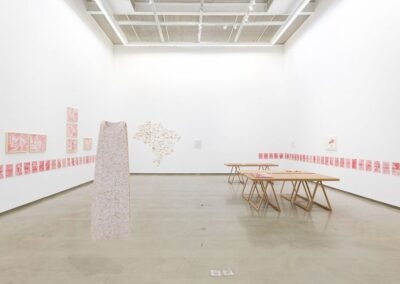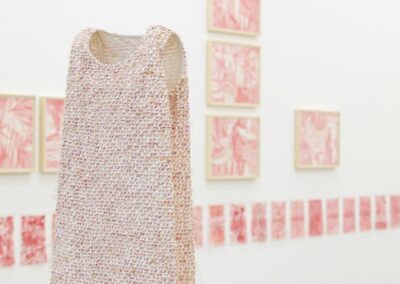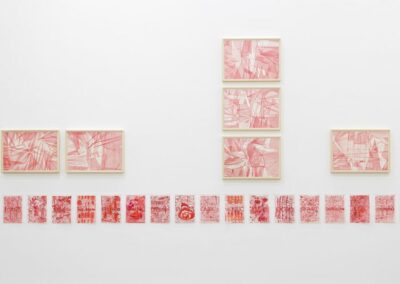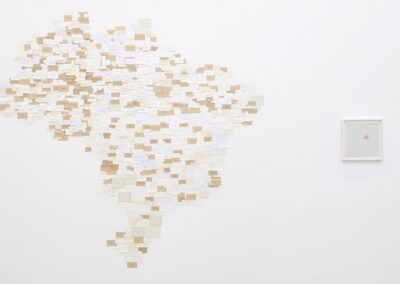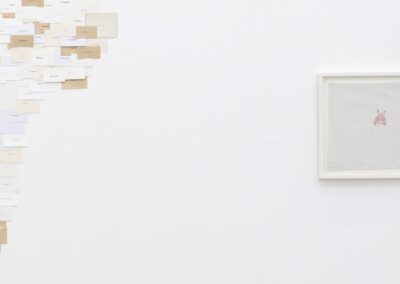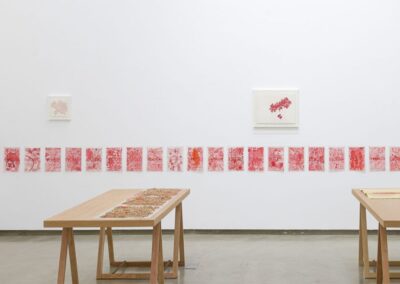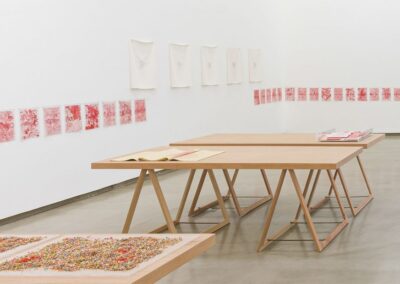QUE NOSSO NOME NÃO CAIA NO ESQUECIMENTO | 2021
Galeria Anita Schwartz, Rio de Janeiro, Brasil
Curator: Bianca Bernardo
Description of works

1 - Memory is the seamstress, and a very fine seamstress at that. Memory makes the needle run in and out, up and down and to and fro. We know not what comes next, what will come later | 2007
The idea behind the making of this dress was to point to what we must remembered: not to forget. It was a collaboration with Cooparoca, the Rocinha community cooperative of 80 women artisans who represent all the women to whom the Memorial-Dress is dedicated. Its inclusion in this exhibition – that deals with Brazil’s structural violence – stems from the need for permanent exposure of violence against women, which increased during the Covid-19 pandemic.
-
- Cotton labels with machine-embroidered initials; cotton frock
- 150 x 50 cm
- EXHIBITIONS: ‘Amor’, Casa Museu de Benjamin Constant, Rio de Janeiro, Brasil / Galerie Caroline Vachet, Lyon, França / ‘Retalhar’, Centro Cultural Banco do Brasil, Rio de Janeiro, Brasil
- access the work page here

2 – History explains but does not justify | 2020-21
Scribbles, lines, smudges, numbers, news items and words are juxtaposed haphazardly albeit with great care upon over one hundred sheets of paper, signaling my outrage against the political handling of the Covid19 pandemic in Brazil, when governmental disdain for human life became abundantly clear, contributing to an obscene increase in the number of avoidable deaths.
- Desegraph pens; China ink; A4 size wax paper A4; Photo Art Bags; Paillard needles Photo Art Bags; agulhas Paillard
- variable dimensions
- access the work page here

3 – Sheets of confinement | 2020-21
A series of line, dot and smudge drawings that began at the start of the Covid19, when we were made to self-isolate, alternating gestures of distress and rage with others that aspired to appeasement and self-control.
-
- Desegraph pens; China ink; Canson paper
- 40 x 60 cm
- access the work page here

4 - We are not one, we are various | 2016
The more than 1.100 names listed in this work underscore the impact of what came to be called the discovery of Brazil; within the context of this exhibition, it exposes the genocide of our indigenous peoples, still in progress, as evinced by the Covid-19 pandemic: the large map calls our attention to the absence of lives and cultures and the subsequent impoverishment of our civilizing process.
- Lettering stencils; China ink; visiting cards that belonged to my parents 220 x 230 cm
- 220 x 230 cm
- EXHIBITIONS: 'Between sky and water’, Paço Imperial, Rio de Janeiro, Brasil
- access the work page here

5 – Indiozinho | 2003
The “Indiozinho” embroidery is one of the first needle and thread drawings I made, dating back to the “Primeiros bordados” [“Early embroideries”]. Alongside the large map of Brazil that contains the names of approximately 1100 indigenous peoples, it occupies the gallery’s central space, from where it observes the movement of all who come and go, even as it inquires about the value of human life in Brazil.
- scraps of cotton fabric; cotton/polyester blend embroidery thread
- 30 x 30 cm
- access the work page here

6 - For you who know who you are | 2018
These dotted lines are a derivation of my maps of chance: the same, albeit smaller sheets of handcrafted paper required delicate intervention to bring about abstractions, aerial views, and distant territories.
- Drawing in China ink on handcrafted paper
- 20 x 20 cm
- access the work page here

7 - Maps of chance | 2013
These drawings of territories emerge from the natural reliefs of the paper itself. A recurring geometric element in my work. circles appear here as fantasy: ghostly flash openings in the forest to provide shelter indigenous villages of peoples who no longer exist – the victims of a colonial process that persists to this day.
- Series of drawings in red China ink on handcrafted paper
- 50 x 40 cm
- EXHIBITIONS: 'Rio’, Salt Fine Art Gallery, Laguna Beach, EUA
- access the work page here

8 - The end since the beginning (2nd color palette) | 2019
In this second color palette, sewing thread has been reduced to dust and transformed into tiny silk pellets to conform imaginary territories in which the concentrated allude to Brazil’s current environmental problems as well as to the growing threat to the land rights of indigenous peoples.
- scissor and friction alterations to silk thread
- 45 x 65 x 10cm / unit
- access the work page here

9 - Targets of violence | 2020-21
Since 2009 I have been drawing these targets of violence on different supports and varied compositions, horrified by the news accounts of deaths by so-called accidental shootings that we know to have primarily victimized disenfranchised black youth. In the present iteration, I began a line-by-line count of the growing annual number of deaths by firearms in Brazil, according to data made available by the Map of Violence since 2018. In this work, the years have been shuffled around and the death numbers may be perceived in the varied dimensions of each target, partially visible according to the handling and transparency of the paper upon which they were made.
-
- China ink on an unbound notebook made of rice paper
- 45 x 120 cm
- access the work page here

10 - Confinement Notebooks | 2020-21
A series of line, dot and smudge drawings that began at the start of the Covid19, when we were made to self-isolate, alternating gestures of distress and rage with others that aspired to appeasement and self-control.
- Desegraph pens; China ink; 29 Moleskine notebooks
- 65 x 45 x 10 cm
- access the work page here

2 - You must forget everything you have been taught | 2016
The resemblance between South America’s mapped waterways and the human heart is underscored by the earliest sketches of the continent (16th and 17th centuries), drawn by Europeans during their territorial disputes. The red thread chosen for the embroidery emphasizes our body’s central organ, in an allusion to affect albeit as a reminder of the violence of this persistent territorial dispute that insists on enduring even as it compromises the country’s civilizing process.
- Set of cotton thread embroideries on Irish linen that belonged to my father
- 70 x 50 cm (cada)
- access the work page here

12 - Red | 2011
Regardless of the refined embroidery, accomplished by twisting the thread around the needle several times prior to perforating the cloth, this work alludes to clotted blood: imposed or willing violence. It also alludes to the idea of a territory in flames. For this reason, it is part of this show with other maps, both historical and imagined.
- French knot embroidery on linen liturgical vestments
- 125 x 78 cm
- EXHIBITIONS: 'Aquilo que nos une’, Centro Cultural Caixa Econômica Cultural, Rio de Janeiro e São Paulo, Brasil
- access the work page here
Photo: Gabriel Marigo
TEXT
MAY OUR NAME NOT BE FORGOTTEN | 2020-21
Bianca Bernardo
Novembro 2021
In the beginning, there was no America. We have always been many, diverse, and vast. When the explorers arrived, they soon wrote letters and books telling of their great discovery and of how they had conquered an “island” in the middle of the Atlantic Ocean.One among many of the perverse ironies that have been around since the beginning of modern times regards the very name chosen to rename the abducted land. The name Brazil emerges as if branded by a deep scar under the sign of shameless exploitation, its past wounded by a burning coal, under the watchful eyes of the guardians of the forest, leaving continuous tracks of destruction, expropriation and deforestation, never asking whether the time has come to stop, for it never should have happened. But the eyes of the guardians of the forest never ceased to sting.
In “Que nosso nome não caia no esquecimento” [“May our name not be forgotten”], Renato Bezerra de Mello’s first solo exhibition at Anita Schwartz, the artist sensitively tackles the demanding task of observing his own times through prisms which tell a story of violence that, for over five centuries, has stilled resistant lives and cultures. Bezerra de Mello thus impregnates the show with the color red to evince a Brazil stained by a flow of blood and the constant brutality of forms of greed, social injustice, prejudice and intolerance.
The will to investigate the notion of an approach to hospitality as a welcome of the other (and based on recognition of the foreigner that lives within himself) is among the apontamentos abissais of the work “Não somos um, somos vários” [“We are not one, we are many”]. The understanding that hospitality takes place between paradoxical relationships of otherness expands the meanings of such a fanciful conceit as docile and absolute welcoming. According to Alain Montandon, the importance of perceiving a gesture of hospitality consists, first and foremost, in rejecting a hostility that is latent in the view of of the guest/foreigner. To create the work, the artist appropriated old visiting cards made for his parents and printed upon the reverse side of each one the names of over 1.100 Brazilian indigenous peoples. The map of Brazil is remade along the spectrum of memory of its original territory, in consonance with a research list prepared by the Museu do Índio in 1998. In it, we confront the horrors inflicted by ethnocide as a motor of the colonial project.
Renato’s malaise in light of the growing banality of death threats in Brazil is transformed into abstract drawings and symbols, lines, stains and scrawls. In the exhibition, an unbound notebook sits upon a table; upon it red mandalas of different sizes may be perceived, line by line, page by page. “Alvos da Violência” [“Targets of Violence”] represents the memory of each death by firearms in Brazil, year by year, accord to official data gathered from the Map of Violence (available to the public since 1980).
The artist’s small “Confinement Notebooks” are filled with drawings about feelings of unease in light of the Covid-19 pandemic, all of which resort to the world of inscription to translate the collective fear and sadness experienced as of the initial orders of social distancing and lockdown. Simultaneously, Renato continued to develop the series “History explains, but does not justify” that he began in 2020. A group of 91 drawings are arranged in the gallery in the manner of the red news tickers of television journalism we watched over the past two years or so, a daily record of uncontrollable deaths by Coronavirus. Following extensive investigations, the Brazilian government’s colossal negligence and incompetence in handling the pandemic engendered a crushing surfeit of revolt and indignation to the indescribable sense of mourning for all of the lost lives and thousands of avoidable deaths. In the face of sweeping despair and wailing, Bezerra de Mello voices the cries and words of upheaval chanted in chorus in the streets and in private lives from windows.
There is no way to romanticize the bloody violence of daylight that has become eternal night. Like Bezerra de Melo, let us continue to seek out practices of cure and care in stories and processes of transmutation through art, surviving oppression and illness through the ancestral cultivation of ways of living in freedom. Thus we must continue our crossing, imagining and dreaming of possible futures in order to postpone the end of the world for yet one more day.
